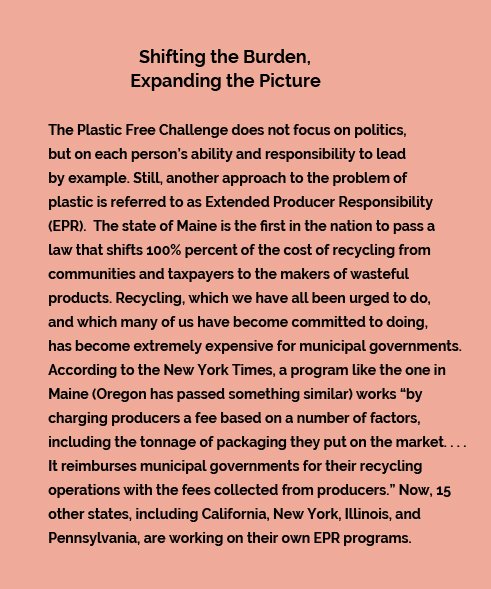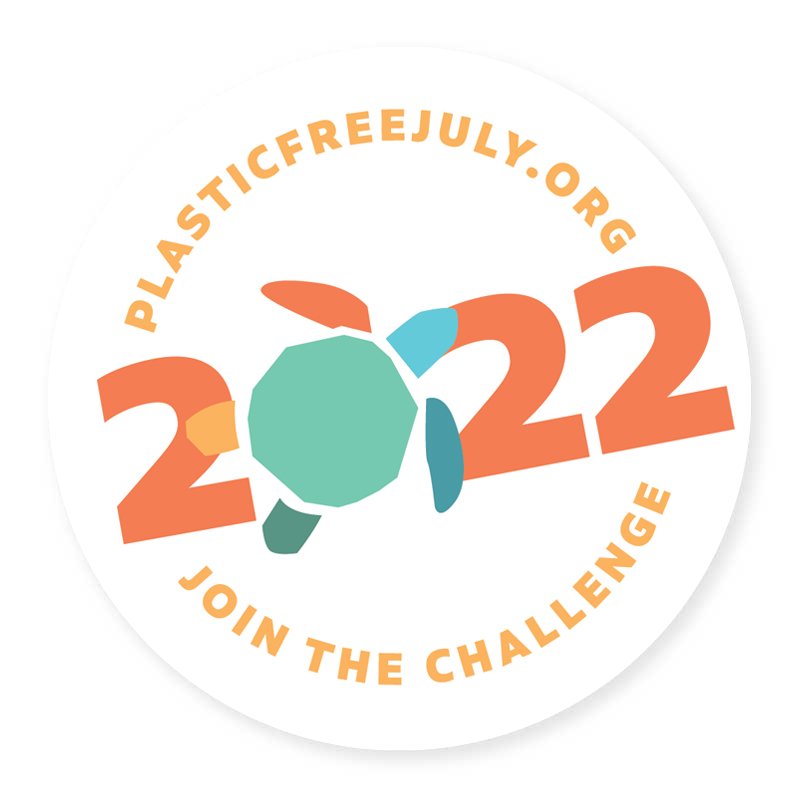By Susan Messer
My husband and I are pretty highly functioning when it comes to plastic-consciousness/plastic-avoidance: For years, we’ve brought our own reusable bags to the grocery store, and we’ve picked up plastic bottles during our walks so we could put them in the recycling bin. We drink from reusable water bottles. Pre-COVID, when we went to restaurants, we brought our own containers for leftovers. We are painfully aware of how flawed and broken the plastic-recycling system is, and aware, too, of the microplastics showing up in marine life, in commercial seafood, and even in drinking water. Not to mention all the corporate money and muscle that drive the massive production of all this plastic. And yet, as I look around my home—at the shampoos and conditioners, moisturizers, dish and laundry soaps, toothbrushes, sun block, the bottle that holds my calcium supplements, the one that holds the Tylenol I took for my headache the night I started thinking about this—I feel daunted at the challenge of living plastic-free.
Plastic Free July is an annual global challenge created to get people thinking about the amount of single-use disposable plastic in their lives, which apparently, they have accomplished with many people, including me. The second part of the challenge is to get us to do something about it—for example, to refuse single-use plastics like straws and bags (I do that), and get merchants to stop automatically offering them to customers (I haven’t yet done much about that).
If you sign up for the plastic-free July challenge, you decide where you’re going to focus (home, work, school), how long you’re going to do it (a day, a week, a month, forever), and which of these three things you’ll commit to:
Avoiding single-use plastic packaging
Targeting takeaway items (bags, bottles, straws, and cups)
Going completely plastic free
Taking on the Challenge
And now here’s Alison Corsino, my lovely neighbor, who actually took the challenge. Let’s ask her a few questions.
Q: How did you decide to do it?
A: It was the summer of 2019. I was at the farmers’ market, and there was Dick Alton, circulating information about making a pledge to go plastic free. I’ve always been interested in reducing waste, and I like a challenge, so I was ready to take the next step. I went to the Plastic-Free July website, and I learned that this was a world-wide movement. The website helped me see the amount of difference it could make, just in July, by removing as much plastic as possible from the equation. Many people seem to feel that one person’s behavior doesn’t make a difference, but when people act together, it can make a difference.
Q: Was it hard?
A: It’s called a challenge for a reason. You have to be very intentional. You have to work at it. You have to change your shopping habits, and it can cost more. For example, you might have to change where you shop. You might have to go to a coop or farmers’ market, to places that use less packaging or that sell items in bulk. You also have to bring your own bags and jars and reusable storage containers. You have to carry all that with you. And the stores have to be willing to weigh things in your containers. In addition to being a challenge, being able to do this is a bit of a luxury. Not everyone has that luxury, but everyone can make small changes. I don’t want anyone to be discouraged. It can actually simplify your buying, as you ask yourself, “Do I really need all of those?”
Q: Tell me about a particularly memorable moment.
A: Trying to buy lunchmeat. All of it is wrapped in plastic. And at the deli counter, I didn’t want to get the turkey sliced and then have the clerk put it in plastic. I’d say “Just give me a hunk. Please don’t slice it. And I only want it wrapped in the white paper.” They thought I was nuts. Some employees would get what I wanted; others would wrap it in the white paper and then put it in plastic without thinking. Eventually, I told my family “We’re not having any more sandwiches this month.”
It can be uncomfortable to be educating people all the time. They can see you as preachy. So you have to be kind and respectful and informative, and then they appreciate what you’re trying to do. And the truth is that I wasn’t 100% plastic free, but I saved my plastic waste in a small plastic bag, and it didn’t amount to much. I saved it as an inspiration for myself beyond July.
Q: What was the effect on the people around you?
A: At work, it caught on with my office mate. We went down to using one garbage can, and we’d empty our can into someone else’s, and when we left at the end of the day, we’d turn our can upside down. Otherwise the cleaning crew—no matter how little waste there is—removes the plastic bag and the contents and replaces it with another one. Besides my office mate, though, other people in the office thought I was nuts.
But I’ve been into this for a long time. When I led a girl scout troop 14 years ago, I announced that we would not be having fruit-juice pouches anymore. The girls whined at first, but then they started bringing their own water bottles, and eventually our troop became waste free.
Q: What has been the lasting effect on you?
A: It’s a way of thinking about what I do and buy. And I try to push it a little further all the time. I look at the plastic-free website to see what others are doing. I know some of these products are not widely available to everyone, but I started using beeswax wraps instead of plastic bags, and I’ve switched to shampoo bars. If I’m having a party, I get sparkling water in glass bottles rather than two-liter plastic bottles. Or I make a pitcher of lemonade with lemons.
And Speaking of Lemons and Lemonade . . .
Here’s Phyllis Rubin, another neighbor and friend, who has found something actually reasonable and useful to do with plastic waste.
Q: How would you like to describe yourself and your relationship with the plastic-free movement?
A: I’m one of the founders of the local group called Go Plastic Free. We got started three years ago at an event for plastic-free July, where we watched a film called A Plastic Ocean [also shown in the 2017 One Earth Film Festival]. This was such a profound experience, to see the destructive impact of plastic, so I said to a small group that remained after the film, “Could we keep meeting about this? I want to keep remembering and exploring this problem.” So we set a time to meet the following month, and we’ve been meeting every month since. Part of what we did was share what we could buy to reduce our plastic consumption—eating utensils to carry with us, wax-covered linen wraps to substitute for plastic wrap, silicone bowl covers, collapsible containers, alternative toothpaste. Even toilet paper without any plastic packaging, from a company called Who Give a Crap.
Then we also started pushing for local and state legislation to ban single-use plastic, and to get a deposit on plastic bottles so they can be returned. Last year, we had a booth during plastic-free July at the Oak Park farmers’ market. We put out samples of things people can do to be plastic free—or really plastic free-er; it’s hard to be 100%. If anyone wants to connect with our group, write to me: [email protected]
Q: Explain about using plastic waste to make benches. How does it work?
Trex® is proud to sponsor local recycling programs throughout the country. If their team can collect more than 500 pounds of plastic refuse, they will donate a high-performance composite bench to your school or community.
A: Around two years ago I learned about the Trex® plastic challenge. The idea is that if you, your school, your organization, collect 500 pounds of soft plastics—what they call “film plastics”—in 6 months, Trex® will make you a bench. I told the Interfaith Green Network about this, and they wanted to do it. We placed collection bins at four sites around town, and we collected 500 pounds in 3 weeks! The places with the collection bins were inundated, so we needed people to be picking up from them every day. So if you want to do this, you need people to help. You also need to weigh and log the collected plastic and send in your weights to Trex® monthly. When you get to 500 pounds, they ask you what color bench you want, and 6ish weeks later, they deliver your bench. We’ve gotten four benches made at this point.
Q: If someone wants to start collecting plastic for a bench, how do they do that?
A: Check it out with your organization and determine where you will place your collection bins. Trex® will send you the bins when you sign up for the challenge. Then you need to get a team together and publicize it. The further you spread the word, the more you collect. Educating people about what they can and cannot donate is key. Mixing in the wrong kinds of plastics can mess things up.





